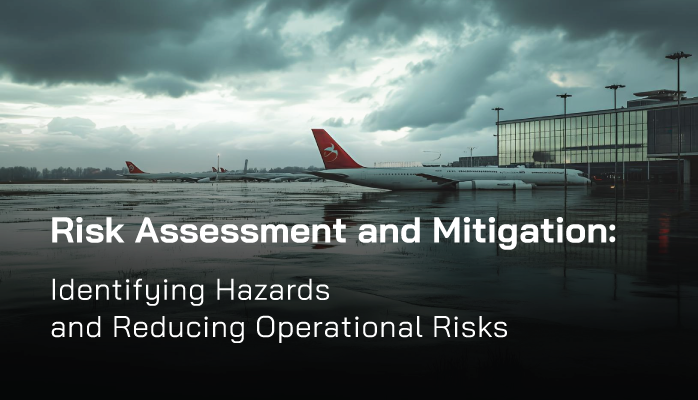A Guide for Aviation Safety Professionals

Unmanned Aircraft Systems (UAS) are transforming aviation, from aerial inspections to emergency response. Yet, their integration into airspace demands rigorous safety management.
The Specific Operations Risk Assessment (SORA), developed by the Joint Authorities for Rulemaking on Unmanned Systems (JARUS), provides a structured framework to assess and mitigate risks for UAS operations. For aviation safety managers, professionals, and accountable executives, mastering SORA ensures compliance with EASA regulations and enhances operational safety.
This guide explores SORA’s risk assessment process, focusing on Ground Risk Class (GRC), Air Risk Class (ARC), and Operational Safety Objectives (OSOs). With practical steps and insights, it equips you to implement SORA effectively, leveraging tools like SMS Pro’s risk management modules to streamline compliance and reduce incidents. Whether you oversee airport UAS programs or utility drone operations, this article offers actionable strategies to elevate your safety program.
Understanding SORA’s Risk Assessment Framework
SORA is a risk-based methodology that evaluates UAS operations to determine acceptable safety levels. Adopted by EASA for the Specific category (non-standard operations), it categorizes risks into ground and air domains, assigning mitigation measures to achieve Operational Safety Objectives. The process involves 10 steps, from defining the Concept of Operations (ConOps) to obtaining regulatory approval.
Key components include:
- Ground Risk Class (GRC): Assesses risks to people and property on the ground, based on population density, UAS characteristics, and crash scenarios.
- Air Risk Class (ARC): Evaluates collision risks with manned aircraft or other drones, considering airspace type and traffic density.
- Operational Safety Objectives (OSOs): Defines safety requirements (e.g., training, maintenance) to mitigate identified risks.
SORA’s flexibility allows operators to tailor risk assessments to their operation’s complexity, but it requires precise hazard identification and mitigation planning. Tools like risk matrices, as detailed in risk matrix guidelines, are essential for structuring SORA assessments.
Assessing Ground Risk Class (GRC)
GRC quantifies the risk of a UAS crashing and harming people or property. It considers factors like population density, UAS size, and kinetic energy on impact. For example, a drone operating over a rural area (GRC 1) poses less risk than one over a city center (GRC 6). SORA’s GRC determination involves three steps:
- Intrinsic GRC: Calculate the baseline risk based on UAS characteristics (e.g., weight, speed) and operational area (e.g., populated vs. unpopulated).
- Mitigations: Apply measures like parachutes or geofencing to reduce GRC. For instance, a parachute system can lower GRC by one level.
- Final GRC: Combine intrinsic risk and mitigations to assign a GRC score (1–10).
Effective GRC assessment requires robust hazard identification. Hazard identification techniques ensure all ground risks, such as battery failure or navigation errors, are addressed. SMS Pro’s Hazard and Risk Register module supports this by cataloging hazards, risk scenarios and tracking mitigations, ensuring EASA compliance.
A practical example: An airport using UAS for runway inspections over a sparsely populated airfield might start with GRC 3. By implementing a redundant navigation system and emergency procedures, it reduces to GRC 1, aligning with SORA’s low-risk threshold.
Evaluating Air Risk Class (ARC)

ARC assesses the likelihood of a UAS colliding with manned aircraft or other drones, based on airspace characteristics. SORA categorizes ARC into four levels (ARC-a to ARC-d), from low-risk uncontrolled airspace (e.g., rural areas) to high-risk controlled airspace (e.g., near airports). The process involves:
- Airspace Analysis: Identify airspace type (e.g., Class G, Class A) and traffic density using tools like airspace maps.
- Intrinsic ARC: Assign a baseline ARC based on operational environment (e.g., ARC-c for operations near an airport).
- Mitigations: Implement measures like transponders or Detect-and-Avoid (DAA) systems to lower ARC.
Airspace risks are dynamic, requiring continuous monitoring. Proactive risk management strategies reduce collision risks. SMS Pro’s Risk Management module, accessible at SMS Pro’s risk management tools, enables operators to track airspace hazards and integrate mitigation data.
For instance, a UAS operator conducting aerial surveys near a regional airport might face ARC-c. By equipping drones with ADS-B transponders and coordinating with air traffic control, the ARC drops to ARC-a, ensuring safer operations.
Implementing Operational Safety Objectives (OSOs)
OSOs are SORA’s safety requirements, tailored to GRC and ARC levels, covering technical, operational, and organizational measures. They include pilot training, maintenance protocols, and emergency procedures. SORA defines 24 OSOs, each with robustness levels (low, medium, high) based on risk severity. Examples include:
- OSO #05: Ensure UAS airworthiness through regular maintenance.
- OSO #11: Train pilots for specific operational scenarios.
- OSO #22: Establish contingency plans for system failures.
Implementing OSOs requires a structured approach. Control measure implementation streamlines compliance. SMS Pro’s Safety Assurance module, detailed at SMS Pro’s safety assurance tools, tracks OSO compliance through audits and performance monitoring.
A practical case: A utility operator using UAS for power line inspections (GRC 2, ARC-b) must meet medium-robustness OSOs. By integrating SMS Pro’s training and auditing tools, it ensures pilots are certified and maintenance schedules are followed, achieving EASA approval.
Leveraging Bow Tie Analysis for SORA
Bow Tie analysis, a visual risk management tool, enhances SORA’s risk assessments by mapping hazards, threats, barriers, and consequences. It’s effective for UAS operations, where risks like battery failure or airspace intrusions require clear mitigation strategies. The process involves:
- Hazard Identification: Define the hazard (e.g., UAS system failure).
- Top Event: Identify the critical event (e.g., loss of control).
- Threats and Consequences: List causes (e.g., battery degradation) and outcomes (e.g., ground collision).
- Barriers: Implement preventive (e.g., pre-flight checks) and mitigating (e.g., parachutes) controls.
SMS Pro’s integrated Bow Tie Analysis module, part of its risk management suite, enables operators to create dynamic diagrams, ensuring all SORA risks are addressed. Bow Tie analysis steps provide a guide for implementation.
For example, a UAS operator assessing a drone delivery operation uses Bow Tie to identify battery failure as a hazard. Preventive barriers (e.g., battery health monitoring) and mitigating barriers (e.g., emergency landing protocols) reduce GRC and ARC, aligning with SORA’s requirements. EASA’s SORA guidelines (EASA SORA resources) emphasize structured risk visualization for approval.
Conclusion: Elevate UAS Safety with SORA and SMS Pro
SORA’s risk assessment framework is a cornerstone for safe UAS operations, enabling operators to navigate EASA’s Specific category with confidence. By mastering GRC, ARC, and OSOs, and leveraging tools like Bow Tie analysis, aviation safety professionals can reduce risks and ensure compliance. SMS Pro’s comprehensive modules, from hazard tracking to auditing, streamline SORA implementation, empowering operators to achieve safety excellence.
To enhance your UAS safety program, explore SMS Pro’s capabilities at asms-pro.com. Download free resources, like our UAS FRAT checklist, at SMS Pro resources, or schedule a demo to see how SMS Pro aligns with SORA. SKYbrary’s UAS safety resources (SKYbrary UAS safety) and FAA’s UAS integration guidelines (FAA UAS integration) offer additional insights.
Take the Next Step in UAS Safety
Ready to streamline your SORA risk assessments? Discover SMS Pro’s risk management tools and start building a safer UAS program today.





